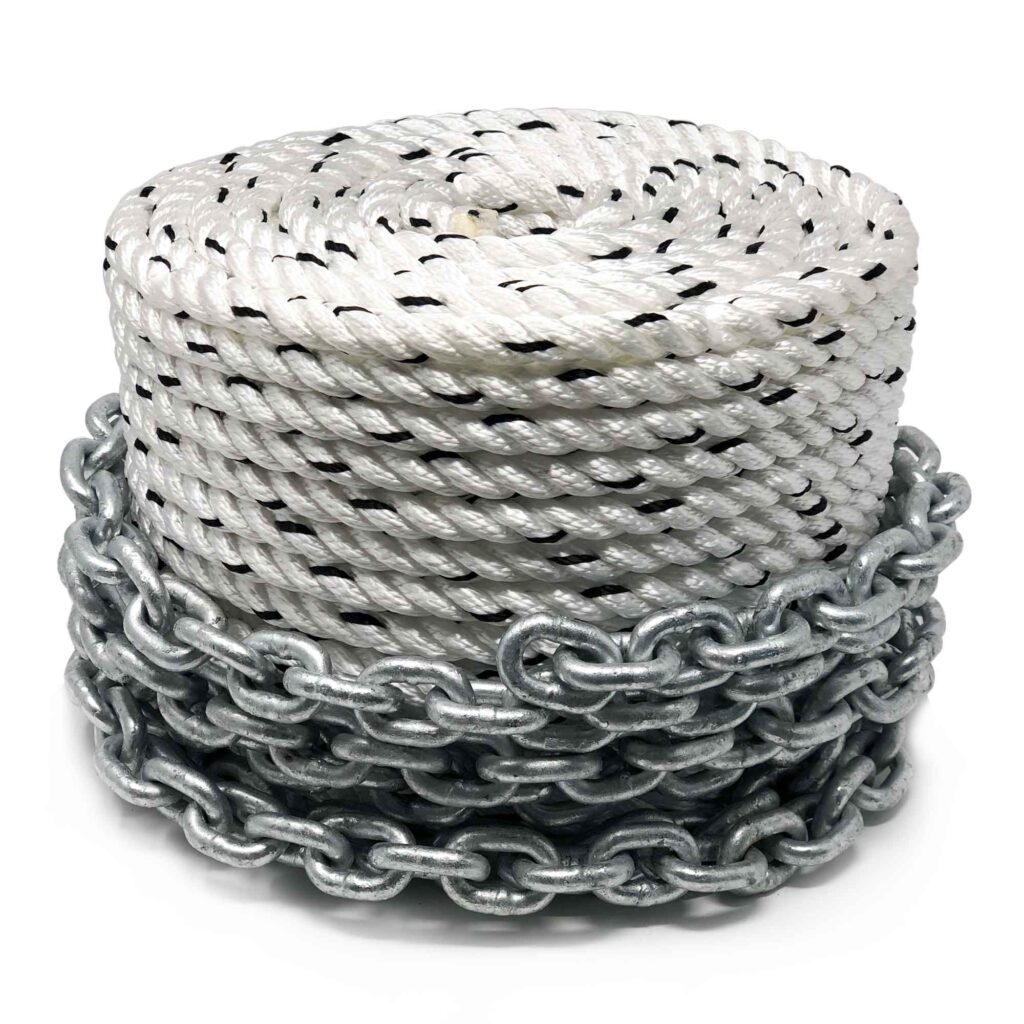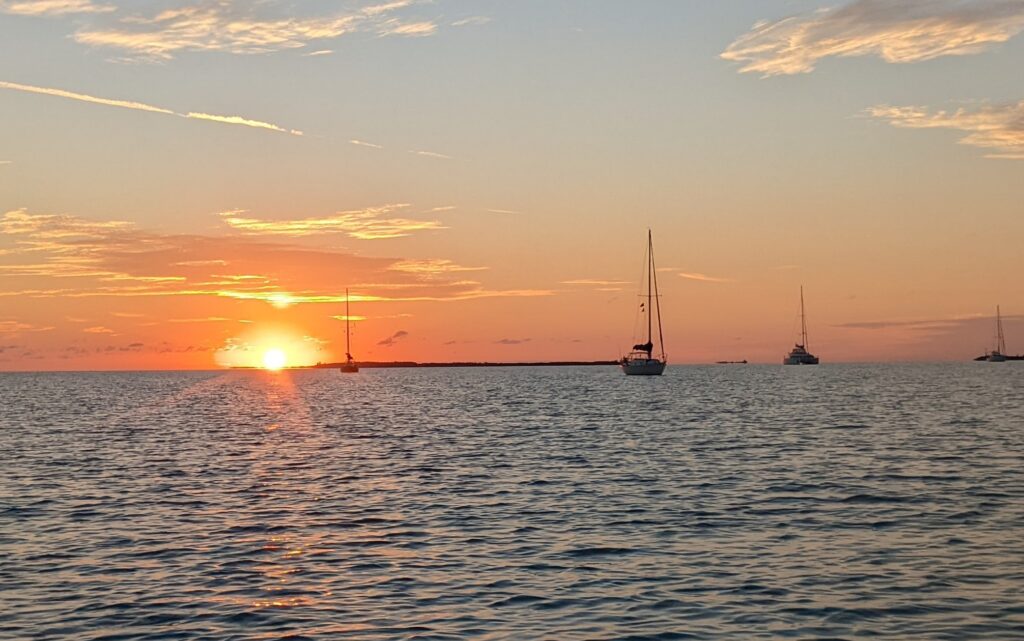Anchor Rode Selection – Part 1 of 3 Anchoring for Beginners
One day, while taking guests out on the Potomac river, I saw a boat that was dead in the water and drifting towards a concrete bridge piling. Its skipper frantically waved at us. After quickly conferring with my guests, we gave them a tow to a nearby marina. When we approached the boat, we saw a beautiful, stainless steel anchor sitting at the bow of the boat, unused. The skipper of the vessel dead in the water did not know how to use his ground tackle. By the time we got there, it would have been too late to deploy the anchor. And it is nobody’s idea of a good day to have their beautiful boat hit a bridge piling!
‘Ground Tackle’ is critical safety equipment. I can safely say that most boats I’ve seen in our local waters have insufficient ground tackle, if they have any to begin with! Even less know how to properly use them. I cannot count the amount of times I have had to seek shelter and set the ‘hook’ to ride out an approaching storm. Sometimes for days! But having proper ground tackle let me sleep easy at night, as the storm rages on overhead.
Even if you are a dock-to-dock day-tripper who wisely pick good weather days to go out on your boat, you should learn how to select and use your ground tackle. You never know when the conditions could turn on you. Besides, it really adds to the boating experience. Resting on a ‘lunch hook’ or spending a night at anchor is really a highlight of anyone’s boating experience.
Bear with me. Ground tackle is a surprisingly complex subject. I will try to keep it as simple and practicable as possible.
Three concepts are critical to understand about anchoring. Rode selection, anchor selection, and scope. We will cover rode selection here. We will talk about the other topics and more on another article. I’m writing this in mind for your typical ‘small’ boat owners who have boats under 40 feet long, typically hand weighing the anchor instead of using a motorized windlass.

An anchor rode is the connection between the boat and the anchor, and is typically made from chain, nylon line, or a combination of the two. You want this rode to help keep the anchor experiences forces that it is best suited to resist – straight back, not up. You also want the rode to absorb shock loading – that is, you want some sort of stretch built into the rode.
An all-chain rode is ideal. Chain will not chafe through anything that it could conceivably touch in the seabed or on your boat. But chain is heavy, which affects the balance and performance of your boat, and requires the use of snubbers, and adds another layer of complexity when you deploy your anchor.
A quick note; a snubber is a length of stretchy material you hook into a chain rode. Think of an extremely heavy duty bungee cord. You make some slack in your chain and connect the snubber onto the slacked chain.
In our local waters of the Chesapeake bay and Potomac river, I personally like to recommend a rode made primarily of three strand nylon rode spliced to a section of chain. Three strand nylon is strong, and already has stretch built-in, negating the need to use snubbers. It is pretty incredible seeing this stretch in action! This line will stretch and stretch until it is very thin, and still maintain its strength. Its also fairly chafe resistant, and can be spliced, tied, and otherwise worked when needed. It is basically beginner friendly, yet extremely capable. On a side note; 8-plait nylon is even better, but it is pricy.
In a really strong storm, regardless of whether your rode is all chain or nylon, your rode will be completely taught. It will make a straight line from the anchor to your bow roller, negating some of the catenary benefits of having an all chain rode. Despite this, its important to have a section of chain between your nylon line and the anchor. In wind and wave conditions below gale force, this chain will largely sit at the sea bed and help your anchor stay horizontal. In fact, it tends to grab the sea bed and add to the holding power of your anchor. Even when your rode is taut from all the wind force pulling on your boat, it still helps to keep the anchor working in the horizontal plane as some of the energy is being used to overcome the chain’s weight before it gets pulled straight. Furthermore, it will protect you from chafe in the lowest, most vulnerable part of the of the rode that is closest to the sea floor.

How long should this section of chain be? Well, longer the better, but my favorite compromise is having a section of galvanized chain at least the length of your vessel. I’m not a big fan of stainless steel chain (nor anchors). Galvanized chain can usually be re-galvanized, and it is also easier to inspect. If you want to have an extra peace of mind, go with 1.5 times the length of your vessel.
Your nylon rode is ideally directly spliced to your anchor. An eye splice with a galvanized thimble works well too, but you have to look out for two things. First, don’t use stainless, because stainless steel in contact with galvanized steel is not good. Secondly, be sure to use the largest galvanized shackle that will fit your chain. You do not want this connection to be the weak link in your rode. And don’t forget to mouse the shackle pin – ideally with galvanized safety wire or a black zip-tie. (And yes, an un-moused pin does come out after some use. Almost reliably!)
What size nylon line and chain should you use? There are numerous charts that list these kinds of specifications. My only warning is this. Do not go more than 1 step ‘up’ from your recommended line diameter for your nylon rode. You need that stretch built-in to your nylon rode.
How long should this anchor rode be? That really depends on the depths of the waters you plan on being in. Not just for the ideal anchorage depths, but taking into account for emergency situations. I recommend getting at least 10 times the deepest reasonably conceivable depth of the areas you’ll cruise. My sailing vessel Sonora is expected to sail the Chesapeake Bay, but also the US East Coast and some of the Caribbean. The anchorages would range from 6 feet to 23 feet. So we carry 250 feet of rode aboard Sonora.
Next up, we’ll discuss Anchor selection.
-Captain Jerry
Reflections DC Boat Cruises